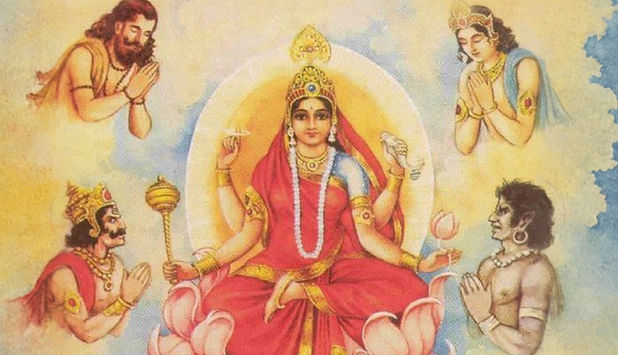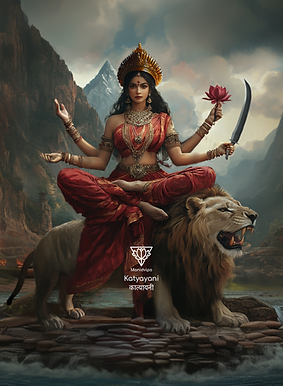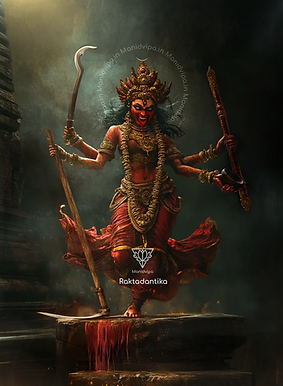
Navadurga
Durga appears in Hindu texts and folklore in numerous forms and names. Navadurga is a group of nine manifestations of the goddess Durga who are worshipped collectively. The names of goddesses vary in different texts.
1. Devi Mahatmyam and the Varaha Purana
According to the Devi Mahatmyam and the Varaha Purana, the Navadurga are presented as a sacred progression that reflects the stages of the goddess’s divine existence. Beginning with Shailaputri, the daughter of the Himalayas, she appears as Brahmacharini, the devoted ascetic, and then as Chandraghanta, the fearless warrior. In Kushmanda, she assumes the role of the cosmic mother whose energy sustains creation, while in Skandamata she embodies maternal grace and protection. As Katyayani, she is the fierce vanquisher of demons, and in Kalaratri she manifests in her most terrifying form to annihilate evil. She then returns as Mahagauri, the radiant goddess of purity, and finally as Siddhidhatri, the supreme bestower of wisdom and perfection.
Together, these nine forms portray the complete arc of the goddess’s life—from daughter and seeker, to mother and warrior, to the ultimate guide and granter of liberation.

1. Shailaputri
She is the manifestation of Durga as the daughter of the mountain. She is depicted with a crescent moon on her forehead and two hands holding a trident and a lotus. Her mount is Nandi. She represents Durga's affiliation with Goddess Parvati.

4. Kushmanda
She is the goddess who produced the cosmic egg with her smile, bringing light to the universe. She is depicted with eight hands holding a discus, lotus, mace, bow, arrow, rosary, and two pots containing honey and blood. Her mount is a tiger.

7. Kalaratri
She is the violent form of Durga. She is depicted in dark skin with four hands, riding on a donkey. She carries a sword and iron hook in her left hands and her right hands are in Abhaya mudra and Varada mudra.

2. Brahmacharini
She is the one who seeks sacred knowledge. She is depicted wearing a white garment and with two hands holding a rosary and Kamandal in her right and left hand respectively.

5. Skandamata
She is the mother of Skanda (Kartikeya). She is depicted with four hands carrying lotuses in her upper two hands and child Kartikeya in the lower right hand and the remaining left hand in Abhaya mudra. Her mount is a lion.

8. Mahagauri
She is the form of Durga with a fair complexion and is considered the goddess of forgiveness. She has four arms, holding a Trident and a tambourine (Damaru) in one of her right and left hands respectively, and the remaining two hands in Abhaya mudra and Varada mudra. Her mount is a bull.

3. Chandraghanta
She is a fierce manifestation depicted with a crescent moon on her forehead. She is depicted with a golden complexion. She has ten hands holding a trident, mace, bow-arrow, sword, lotus, bell, and kamandal, while one of her remaining hands is in Abhaya mudra. Her mount is a tiger.

6. Katyayani
She is a fierce manifestation who slew Mahishasura. She is depicted with four hands carrying a lotus flower and sword in her left hands and her right hands in Abhaya mudra and Varada mudras. Her mount is a lion.

9. Siddhidhatri
She is the ninth form of the Goddess Durga, who provides Siddhi (spiritual power) to all her devotees. She is depicted seated on a lotus, with four hands holding a mace, chakram, a lotus flower, and a conch shell.
According to the Agni Purana, the Navadurga goddesses are Ugrachanda, Prachanda, Chandogra, Chandanayika, Chanda, Chandavathi, Chandarupa, Atichanda, and Rudrachanda. They are all regarded to be among Chandi's forms in Rambhākalpa.
The goddess Ugrachanda is represented with 18 arms. In her right hand, she carries a head, shield, mirror, index finger posture, bow, flag, drum, one sort of shield, and a rope/noose. In her left hand, she carries a spear, hammer, trident, thunderbolt, sword, goad, arrow, discus, and śalāka.
The other eight forms are Rudrachanda, Prachanda, Chandogra, Chandanayika, Chanda, Chandavati, Chandarupa, and Atichandika. They are 16-armed Durga, holding everything but the drum and the index position. These goddesses have a variety of skin tones: yellow like cow urine, red like the sun, black, blue, white, smoke-colored, yellow, and proper white.
2. Agni Purana
3. Aparajita Stotram
1. Mahalakshmi: When part of the Navadurga group, she is depicted with six arms, holding a trident, khadga, panapatra, and naga (snake), and the remaining two hands in Abhaya and Varada mudra.
2. Nanda: She is depicted with four arms, holding rosary, khadga, khetaka, and panapatra.
3. Ksheemankari: When part of this group of goddesses, she is depicted with four arms, holding a trident, lotus, panapatra, and one hand in the Varada mudra.
4. Shivadhuti: She is the one who sent Shiva as a messenger to demons, Nishumbha, and Shumbha, giving them a chance to change their path. She is shown in a horrific manner, screaming like a hundred jackals.
5. Mahachandi: When part of the Navadurga, she is depicted with four arms, carrying khadga, khetaka, trident and ghanta (bell).
6. Bhramari: She is the manifestation of Durga associated with bees, hornets, and wasps. She is depicted with bees clung onto her body and holding a trident, mace, sword, and shield in her four hands.
7. Sarvamangala: She is depicted with four arms, carrying a vajra (a type of club with a ribbed spherical head), rosary, panapatra, and ghanta.
8. Revati: She is also depicted with four arms, carrying a danda (stick), trident, panapatra, and khatvanga (a long club).
9. Harasiddhi: She is who assures fulfillment. She is depicted with four arms, holding a damaru (a small two-headed drum), panapatra, kamandalu, and khadga.
4. Nine Forms of the Goddess in the Durga Saptashati
In addition to the well-known Navarātri Navadurga, the Devi Mahatmya (also called the Durga Saptashatī) identifies another sequence of nine manifestations of the Goddess. These forms are revealed in the eleventh chapter, where the Goddess proclaims the various ways she will appear in future ages to protect the world. They include the great triad of Mahākālī, Mahālakṣmī, and Mahāsarasvatī, along with epithets such as Nanda, Raktadantikā, Śatākṣī/Śākambarī, Durgā (after slaying the demon Durgama), Bhīmā, and Bhrāmarī. Unlike the Navarātri cycle that symbolizes stages of the Goddess’s life and is celebrated in ritual, this set functions as a series of prophetic names, each tied to a distinct mythic episode or future intervention.

1. Mahakali
oddess Mahakali, the highest form of Kali, embodies ultimate reality and cosmic order. Often depicted with ten heads, ten feet, and ten arms holding diverse attributes, she symbolizes infinite power and universal balance. In some representations, she appears with a single head, known as Ekamukhi Mahakali. She is also revered as the Yoganidra of Vishnu, signifying the cosmic sleep that sustains creation.

4. Nanda
Goddess Nanda is revealed as a radiant and divine form of Mahalakshmi. She is prophesied to be born as the daughter of Nandagopa, and it is said that one who worships her with deep devotion can gain influence over all three worlds.
She is adorned in golden brilliance—clad in lustrous golden garments, with a complexion that glows like pure gold, and embellished with the finest golden ornaments. Nanda appears in a resplendent four-armed form, holding a lotus, goad, rope, and conch. She is seated gracefully upon a golden lotus, embodying the combined essences of Indira, Kamala, and Lakshmi.

7. Sahasrabhuja Durga
Known as the thousand-armed form of the Goddess, Sahasrabhuja Durga arose to defeat Durgamasura, a demon who had disrupted the cosmic order and caused famine by stealing the Vedas. Each of her thousand arms carried a weapon given by various gods, making her a formidable force in battle.

2. Mahalakshmi
In the Devi Mahatmya, Durga manifests as Mahalakshmi to vanquish the buffalo demon, Mahishasura. This fierce form of the goddess is described with eighteen arms, each wielding divine weapons such as the bow, trident, discus, and thunderbolt, symbolizing her unparalleled power. Often depicted in the act of slaying Mahishasura, Mahalakshmi represents the ultimate triumph of dharma over adharma.

5. Raktadantika
Raktadantika is a fierce and awe-inspiring form of the Goddess described in the Moorthi Rahasyam of the Devi Mahatmyam. Clad in crimson garments, with a complexion as red as blood, she is adorned head to toe with blood-drenched ornaments. Her eyes, weapons, hair, nails, and even her fangs shine with the hue of battle. She is both terrifying in form and tender in devotion.
With weapons like a sword, pestle, plough, and drinking vessel, she is also called Raktha Chamunda and Yogeshwari, encompassing all forms of power. Her divine body is vast, her breasts as resplendent as the twin Meru mountains—nourishing her devotees with the essence of fulfillment and joy.

8. Bheema
A formidable and awe-inspiring form of the Goddess, Bheema is described as blue-hued, with a massive, towering form. Her wide, intense eyes and gleaming, protruding teeth radiate fearlessness, while her powerful feminine body is marked by full, rounded breasts that embody strength and primal energy.
She wields a drum, sword, severed head, and drinking vessel. Known also as Ekaveera and Kalaratri, she represents the darkest night that destroys ignorance and fear.

3. Mahasaraswati
Mahasaraswati represents the Sattva Guna and the pinnacle of wisdom and creativity. Emerging from Parvati’s body to slay Shumbha and Nishumbha, she embodies the triumph of knowledge over ignorance. With eight hands holding weapons and symbols of creation, she blends nurturing and destructive energies, guiding us toward enlightenment.

6. Śatākṣī/Śākambarī
The deep blue goddess of nourishment and healing, Sakambari is described in the Moorthi Rahasyam of the Devi Mahatmyam as a compassionate yet powerful form of the Divine Mother. Her eyes resemble blue lotus petals, her navel is deep and adorned with three sacred lines, and her form radiates strength and abundance with full, rounded breasts.
She is depicted with eighteen arms, each carrying distinct attributes. Sakambari holds weapons, herbs, fruits, and greens, all capable of removing hunger, thirst, disease, and death. She is Sathakshi—the goddess of a hundred eyes—forever watchful of the world’s pain.

9. Brahmari
Brahmari is a radiant form of the Goddess, shining like a luminous cloud, glowing with hues of many colors. Her form is adorned with diverse ornaments and markings, each adding to her mesmerizing brilliance.
She holds in her hand a bee of many shades—vibrant and ever-shifting—a symbol of her fierce, buzzing energy. Revered as Maha Mai, she is known for her power to overwhelm enemies with a swarm of divine bees and protect the world from unseen harm.
5. Brahmanda Purana
1. Nilakanthi: She is the bestower of wealth. She is depicted with four arms, holding a trident, khetaka, panapatra, and one hand in Varada Mudra.
2. Kshemankari: She is the bestower of health. She is depicted with four or ten arms, holding attributes of a trident, sword, a lotus, chakra, mace, khetaka, battle axe, bow-arrow, a drinking vessel, and one hand in Varada Mudra or Abhaya Mudra.
3. Harasiddhi: She is who assures fulfillment. She is depicted with four arms, holding a damaru (a small two-headed drum), panapatra, kamandalu, and khadga (a type of sword).
4. Rudramsha: She is the dark-complexioned form of Durga shown seated on a lion. She has four arms, holding a trident, khadga, conch shell, and chakra. She is who represses the anger of Rudra.
5. Vana Durga: She is the goddess of the forest. She has a green complexion and is eight-armed, holding a conch shell, chakra, khadga, khetka (a kind of sword), bow, arrow, and trident.
6. Agni Durga: She is the form of Durga associated with fire. She is depicted with eight arms, carrying chakra, khetaka, fire, ankusha (elephant goad), bow, and arrow.
7. Jaya Durga: She is the goddess of victory depicted in a dark complexion riding a lion and adorned with a crescent moon on her forehead. He has four arms, carrying a conch shell, chakra, khadga and a trident.
8. Vindyavasini Durga: She is the goddess who resides atop the mountains of the Vindhya region. She is often associated with the form of Yogmaya who was born as the daughter of Yashoda. As one of the nine forms of Durga, she is depicted with four arms carrying chakra and a conch shell and the remaining one right hand in Abhaya, and the left hand holding a lotus with a bird
9. Ripumari Durga: She is a fierce form of Durga, shown with two arms, holding a trident and the other hand in Tarjani mudra.
6. Navapatrika of Eastern India
The Navapatrikā (literally, “nine leaves”) is a collective form of the Goddess Durga worshipped during Durga Puja and Navarātri, particularly in Bengal and eastern India. The ritual is deeply symbolic, representing nine manifestations of the Divine Mother through the consecration of nine different plants, each tied to a specific goddess. The Navapatrikā is traditionally bathed in the river at dawn on Mahāṣṭamī and then placed beside the image of Durga, where she is venerated as a living embodiment of the goddess herself. While its strongest expression is found in Bengal’s Durga Puja, references to the worship of plants as embodiments of the goddess appear in texts such as the Kālika Purāṇa and the Bṛhaddharma Purāṇa, as well as in several Tantric sources that prescribe the consecration of vegetation in place of living goddesses. The Devi Mahatmya also affirms the presence of the goddess in trees, rivers, and plants, providing the theological basis for such practices. The specific set of nine plants and their association with individual goddesses, however, reflects local agrarian life and is preserved through regional ritual manuals and traditions. Thus, the Navapatrikā represents a synthesis of Purāṇic authority and folk devotion, embodying the goddess’s presence both in scripture and in the natural world that sustains human life.

1. Śivānī (Bilva / Bel leaves)
Śivānī is embodied in the sacred bilva tree (Aegle marmelos), whose trifoliate leaves are closely associated with the Shakti of Lord Śiva and the Matrika, Maheshvari.

4. Kārtikī (Jayantī leaves)
Kārtikī is worshipped through the leaves of the jayantī plant (Sesbania sesban). Regarded as a protective and medicinal plant, jayantī signifies victory and resilience. In the Navapatrikā, it invokes the protective strength of the goddess in her martial aspect.

7. Lakṣmī (Rice paddy)
Lakṣmī, the goddess of wealth and abundance, is represented by the rice paddy (Oryza sativa). As rice sustains life in agrarian cultures, its inclusion highlights the nourishing and prosperous aspect of the goddess, sustaining both households and communities.

2. Raktadantikā (Pomegranate leaves)
Raktadantikā is represented by the pomegranate plant (Punica granatum). The red seeds and leaves evoke vitality, fertility, and fierce energy, expressing the goddess’s aspect as a destroyer of evil and a source of creative life force.

5. Śōkarahitā (Ashoka leaves)
Śōkarahitā, “she who is free from sorrow,” is represented by the ashoka tree (Saraca asoca). Associated with joy and auspiciousness, the ashoka is traditionally linked to fertility and love.

8. Kālikā (Colocasia leaves)
Kālikā is embodied in colocasia (Colocasia esculenta), a plant with broad, dark green leaves. Its association emphasizes Kālikā’s transformative and life-sustaining powers, signifying both fertility and the fierce strength.

3. Durgā (Turmeric plant)
The turmeric plant (Curcuma longa) embodies Durgā herself. Turmeric is a sacred purifier in Hindu ritual, its golden color symbolizing prosperity and sanctity. As part of the Navapatrikā, it affirms the goddess’s role as the remover of impurities and the bestower of well-being.

6. Cāmuṇḍā (Arum leaves)
Cāmuṇḍā, the fierce slayer of Chanda and Munda, is symbolized by the arum (Amorphophallus paeoniifolius). Hardy and enduring, the arum reflects her terrifying strength and unyielding power to eradicate hostile forces.

9. Brāhmaṇī (Banana leaves)
Brāhmaṇī, one of the revered Sapta-Mātṛkās, is represented by the banana plant (Musa paradisiaca). The plant itself is considered highly auspicious and ritually pure, symbolizing continuity, fertility, and sacred nourishment.
7 Nava Gauri of Varanashi
There are also nine different manifestations of Goddess Gauri (Parvati) who are enshrined in Varanasi. These local forms of the goddesses are worshiped together at Navratri, similar to the Navadurga. They are Mukhnirmalika Gauri, Jyeshta Gauri, Saubhagya Gauri, Shringar Gauri, Vishalakshi Gauri, Lalita Gauri, Bhavani Gauri, Mangla Gauri, and Mahalaxmi Gauri. Their temples are situated at different locations across Varanasi. (Read: Regional Goddesses)
Note:
This content has been refined using AI-assisted proofreading tools for clarity and structure. However, all historical and cultural information presented is based on references and sources.









